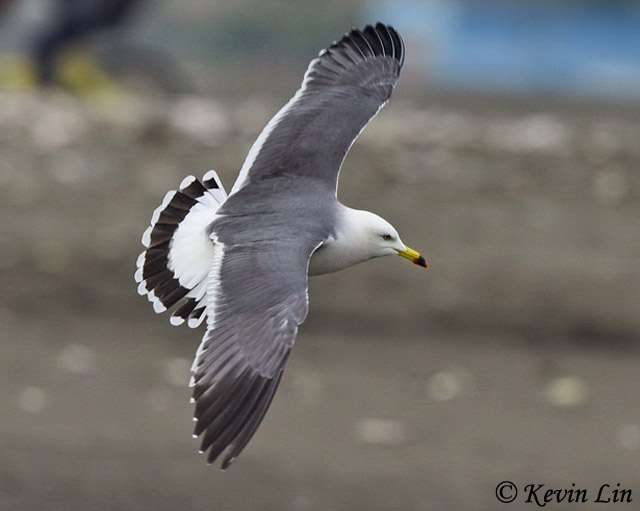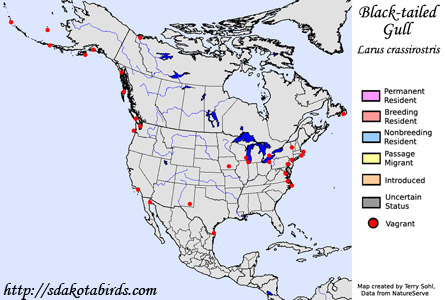| Length: 19 inches | Wingspan: 50 inches | Seasonality: Non-resident in South Dakota |
| ID Keys: White rump, dark tail with white edges, dark grey mantle, white underparts, yellow legs, yellow bill with black and red tip | ||
 The
Black-tailed Gull is a native of eastern Asia. In North America, they are
rare visitors, but they have been found in many locations, including on the
Atlantic coast. They are well named, with the trademark white rump and
black tail making the Black-tailed Gull relatively easy to differentiate
from other Larus gulls with similar body plumage. In Southeast Asia,
they are sometimes referred to as the "cat gull", a reference to their
cat-like, mewing call.
The
Black-tailed Gull is a native of eastern Asia. In North America, they are
rare visitors, but they have been found in many locations, including on the
Atlantic coast. They are well named, with the trademark white rump and
black tail making the Black-tailed Gull relatively easy to differentiate
from other Larus gulls with similar body plumage. In Southeast Asia,
they are sometimes referred to as the "cat gull", a reference to their
cat-like, mewing call.
Habitat: Found in coastal environments, near quieter waters such as estuaries and bays. Breeding colonies are found in rocky coastal cliffs, or sandy shorelines. Post-breeding birds disperse and may be found well offshore, but still typically remain in the same southeastern Asian waters.
Diet: Omnivorous. Food items may include fish, crustaceans, mollusks, insects, marine worms, carrion, and refuse.
Behavior: Uses a variety of foraging techniques, depending upon location and food item. They will harass other seabirds to steal their food. They have adapted well to a human presence, and will follow ships for scraps and offal.
Nesting: A colonial nester, some colonies of Black-tailed Gulls may number in the thousands. The nest is a grassy shallow mound with a depression in the middle. The female lays 2 or 3 eggs, and both parents help to incubate them. When the eggs hatch, both parents help raise the young.
Interactive eBird Map: Click to access an interactive eBird map of Black-tailed Gull sightings
Song: Has a harsh, cat-like mewing call.
Migration: Breeds along the coastlines of China, Korea, Japan, Vietnam, and eastern Russia. They do disperse from breeding areas once young have fledged, but are not long-distance migrants, with most birds wintering in the same southeastern Asian haunts.
Similar Species: Similar to other Larus gull species in general structure and body plumage, but tail pattern makes the gull relatively easy to identify.
Conservation Status: Populations are large and stable, and they are found over a wide geographic area. The IUCN lists the Black-tailed Gull as a species of "Least Concern".
Further Information: 1) BirdWeb.org - Black-tailed Gull
2) BirdLife International - Black-tailed Gull
3) AvianWeb - Black-tailed Gull
Photo Information: Photo taken by Kevin Lin - Photo licensed under Creative Commons Attribution NonCommercial ShareAlike 2.0 Generic License.
| Click below for a higher-resolution map |
 |
| South Dakota Status: Non-resident in South Dakota |
Additional Black-tailed Gull Photos (coming soon!!)
